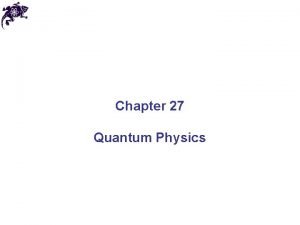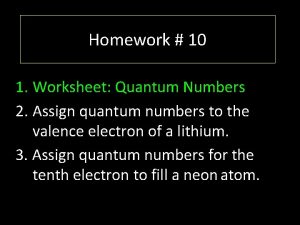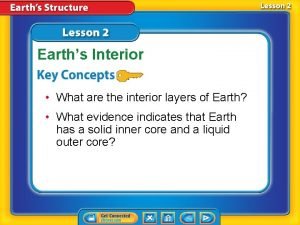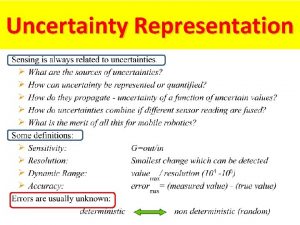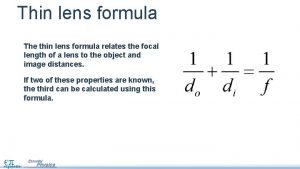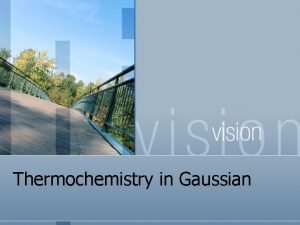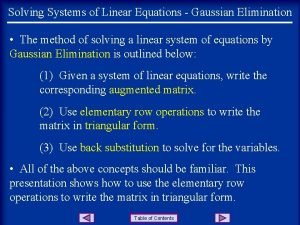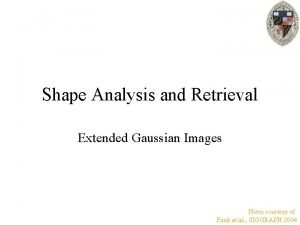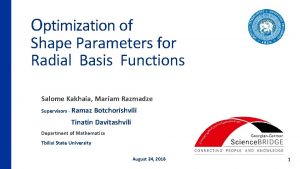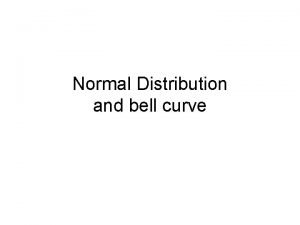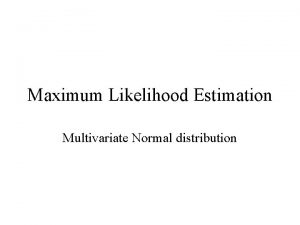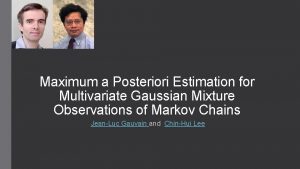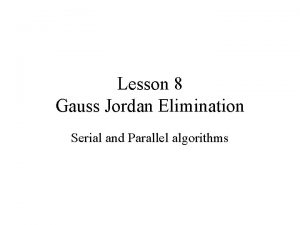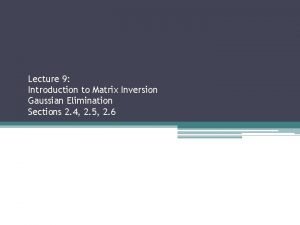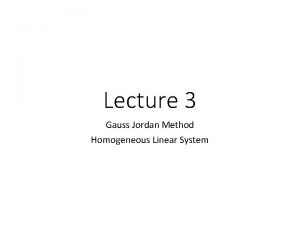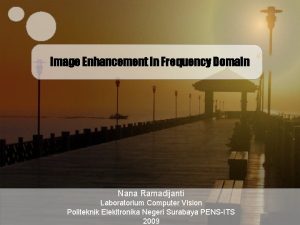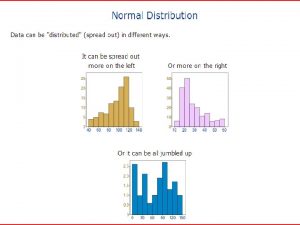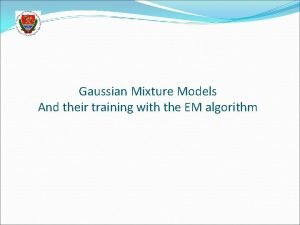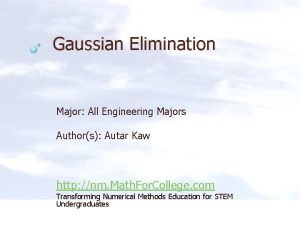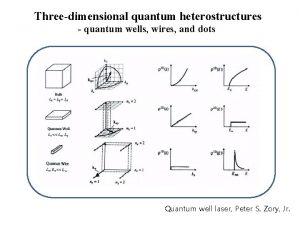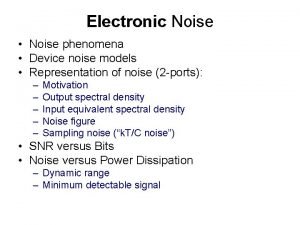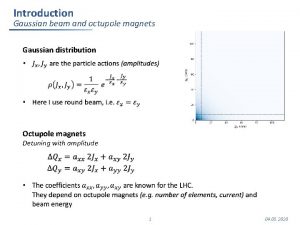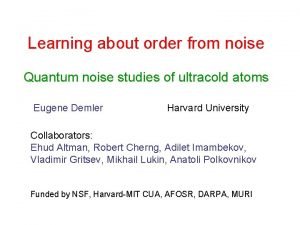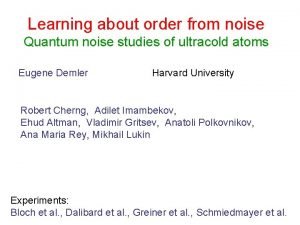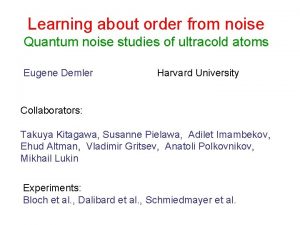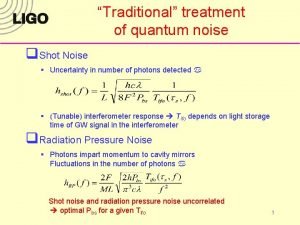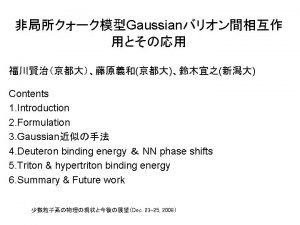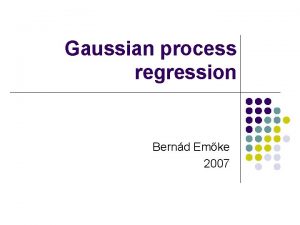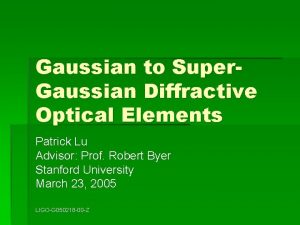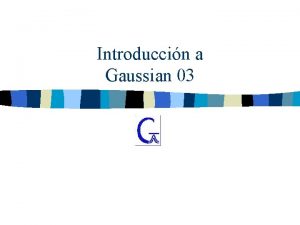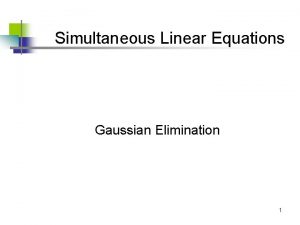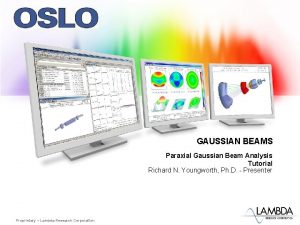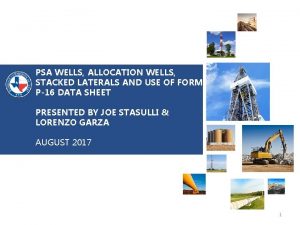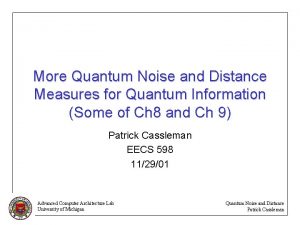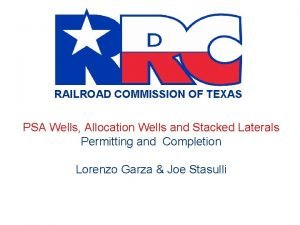Non Gaussian Noise in Quantum Wells Answers and


























- Slides: 26

Non Gaussian Noise in Quantum Wells Answers and UPON Questions Yossi Paltiel and Grzegorz Jung Soreq Solid State Physics Group, Soreq NRC Department of Physics, Ben Gurion University

Contents • Quantum wells and QWIPs • Noise in wells • Non Gaussian noise in wells • Our simple model (what we think we understand) • UPON Open issues This work is a part of M. Sc. thesis of Noam Snapy and Avi Ben Simon

Quantum well infrared photodetectors QWIPs The detection of different wavelengths can be easily controlled by changing the well width Lw, and the energy barrier height h. h - barrier height, changes with Al concentration Lw - width of the well, changes with the thickness of the layer h Lw E = hν Quantum well Photon excites an electron to produce a measurable current e- Voltage bias x 50 m* effective mass, n - an integer

Current Transport in QWs (a) Thermionic emission (b)Thermally assisted tunneling (c) Ground state sequential tunneling (d) photocurrent Continuum Conduction band (a) Energy (b) Bound state - (d) (c) Z Mechanisms contributing charge carriers to the current flow in the conduction band. Doping can be n or p

Noise in QWs • Generation-recombination (GR) noise is accepted as the dominant noise source in bound to continuum QWs. • GR noise is Gaussian. • A general theoretical formula for the PSD of the GR noise at low frequencies was provided by Beck: Shot noise GR noise

Noise one expects to see in quantum wells Lorentzian power spectral density of the GR noise is frequency independent up to a cutoff frequency, located in the GHz range, above which it decays as 1/f 2 Gaussian noise…and white noise at low frequencies

Measurement system Grounded Out shield Computer Blackbody radiation Kithley 6487 picoampermeter Dual channel spectrum analyzer SR 785 Home made or Femto transimpedance amplifier Shielded Dewar grounded to TI 77 K Battery Our samples system consist of 5 wells with the same structure in both n and p type QWIP Structure Ga. As semi insulating substrate p+ Ga. As Buffer 500 nm Ga. As Spacer 100 nm Barrier Al. Ga. As 30% 50 nm QW Ga. As p+ 4. 6 nm Barrier Al. Ga. As 30% 50 nm Ga. As Spacer 100 nm p+ Ga. As contact 500 nm 2 x 1018 cm-3 undoped 5 x 1017 cm-3 undoped 2 x 1018 cm-3 Al. Ga. As

PSD of n and p-QWs at 77 K n type wells p type wells Going to 1/f 2 AT LOW FREQUENCIES in both cases – Open question The high frequency plateau represents the GR noise level, while the low frequency plateau represents the excess noise. Additional noise at certain voltages

Time Domain Measurements in p-QWs T=77 K Gaussian noise RTN -like noise Discreet noise ? ? ? Non Gaussian noise appears at intermediate bias levels

Time domain analysis

Normalized skewness of the noise The amount of asymmetry in the noise amplitude distribution is characterized by the third moment, skewness. P type N type Gaussian noise has no third moment – non Gaussian noise

Trying to understand… • New type of noise in quantum wells. • Appears in both n-type and p-type wells. More pronounced in p-type systems. • Lorenzian spectra with the cutoff at low frequencies. • Non Gaussian.

I-V for n- and p-QWs non exponential increase of the current n-type QWs : Characterized by very low capture probability, therefore more widely used in devices. p-type QWs: Characterized by very high capture probability. Strong tunneling effects.

Low frequency cutoff p type Frequency domain: Bias dependence of the cut-off frequency determined from the spectra. Dark current noise spectrum for different positive voltages at 77 K. Exponential growth with different exponents a = 0. 6 and a = 1. 45 below and above 2. 5 V, respectively.

Non Gaussian noise level and I-V Gain the probability for electron to be collected There is a clear correlation between I-V shape and noise levels

Non Gaussian noise in N-type wells vs. I-V

Conclusions so far… • Experiments suggest the same, or at least very similar, mechanism of excess non-Gaussian current noise in n and p-QWs. But is it true? • Non Gaussian noise can be associated with two, or more, possible solutions to the current continuity equation. • Each solution is associated with a different potential distribution, corresponding to a different resistance, and consequently different currents flowing in the system at the same voltage bias. • The potential distributions are metastable and random switching between them results in non-Gaussian excess current noise.

Simple model

Possible mechanisms for NDR • N type: – Intervallic scattering – Impact ionization • P type: – Different tunnel rate of light and heavy holes ? – Impact ionization

Intervalley scattering “Quantum Gunn effect” • NDC in bulk Ga. As appears as a result of intervalley scattering between Γ, L and X conduction energy subbands. • In n-QWs, at intermediate voltages under illumination, intervalley scattering results in current plateau and NDC in the homogenic equation of the current. • The homogenic equation is composed of the dark current and the photocurrent.

Open questions • Difference between N and P – P more pronounced – Random telegraph noise only in P wells – Difference in high moments – Due to difference in capture probability? Light/heavy holes? • Discreet levels of noise – no real explanation • No real match between I-V kink and noise kink in p type • 5 wells system • Difference between dark and under illumination noise

Summary • Non Gaussian noise in both n and p type wells • More preannounce in P type wells • Attributed to nonlinear I-V and gain • Two solutions to the continuity equation allow existence of metastable voltage states • Some open questions; your suggestions are welcomed!

Nanodots crackling noise? internal avalanche dynamics with widely distributed amplitudes Au Au Ga. As n-Ga. As Al. Ga. As semiinsulating Ga. As semi-insulating substrate Ga. As crackling noise 5 nm 50 nm Crackling avalanche noise as measured in transport through transistor coupled to a nanodots system

Gaussian noise The most familiar functions characterizing noise records of some variable x( t ) are: two-point correlation function power spectral density Mathematically, Gaussianity means that every multipoint correlation function can be obtained by summing all factorizations into two-point products, each of which is replaced by the two-point correlation. For example, assuming <x>=0, For Gaussian noise all higher order time correlation functions and any of their Fourier relatives are fully determined by S(w).

Non-Gaussian noise • In the non-Gaussian noise higher moments are important and proper analysis requires measurements of multipoint correlations: §All the information contained in a record of a Gaussian noise is obtainable from S(w). For Gaussian systems all the information can be obtained from the response measurements. §Only non-Gaussian fluctuations provide information which is not available otherwise. §Just the mere non-Gaussian character of the noise indicates that it cannot be due to a combined action of many elementary fluctuators. Random Telegraph Noise Where: τup and τdown are the average life times at the up and down levels respectively.

Proposed model Two voltage distributions Iin Iw pc ~1 2 QWs I in Pc I in E 1 Iw 1 QW E 2 No NDC Pc Iin pc <<1 Lp Lp Iw (1 -Pc )I in Iw Iw Lp E 1 +Lp E 2 =V Log. I in µ E 1 =V/L p -E 2 Log. I w µ E 2 Iw =Pc I in With NDC Pc Iin Iw "up" state "dn" state Single State E 2
 The noise that affects pcm
The noise that affects pcm Classical mechanics
Classical mechanics Quantum physics vs mechanics
Quantum physics vs mechanics En moi seigneur viens mettre un autel
En moi seigneur viens mettre un autel Chapter 27 quantum theory answers
Chapter 27 quantum theory answers Quantum numbers of neon
Quantum numbers of neon Gaussian elimination and gauss-jordan elimination
Gaussian elimination and gauss-jordan elimination Earth's layers
Earth's layers Muslim irrigation and underground wells
Muslim irrigation and underground wells Gaussian standard deviation
Gaussian standard deviation What is the lens formula
What is the lens formula Gaussian thermochemistry
Gaussian thermochemistry How to do gauss elimination method
How to do gauss elimination method Extended gaussian image
Extended gaussian image Gaussian nosymm
Gaussian nosymm Gaussian function parameters
Gaussian function parameters Normal distribution
Normal distribution Likelihood function
Likelihood function Maximum a posteriori estimation for multivariate gaussian
Maximum a posteriori estimation for multivariate gaussian Gauss-jordan method.
Gauss-jordan method. Matrix inverse gaussian elimination
Matrix inverse gaussian elimination Gaussian probability distribution function
Gaussian probability distribution function Gaussian jordan elimination
Gaussian jordan elimination Gaussian low-pass filter
Gaussian low-pass filter Normal.curve percentages
Normal.curve percentages Training gaussian mixture models at scale via coresets
Training gaussian mixture models at scale via coresets Naïve gauss elimination
Naïve gauss elimination




